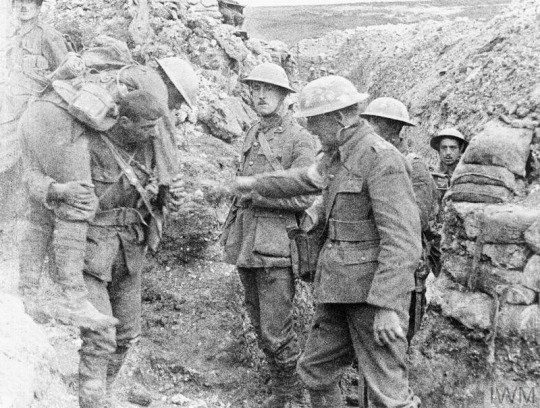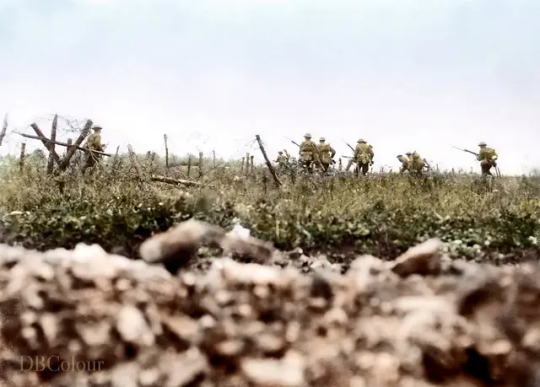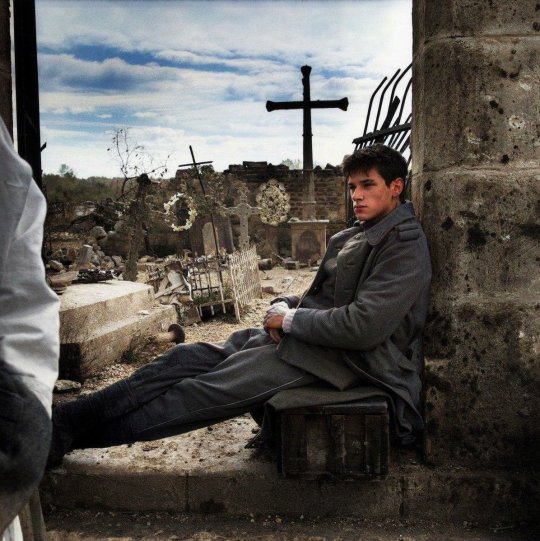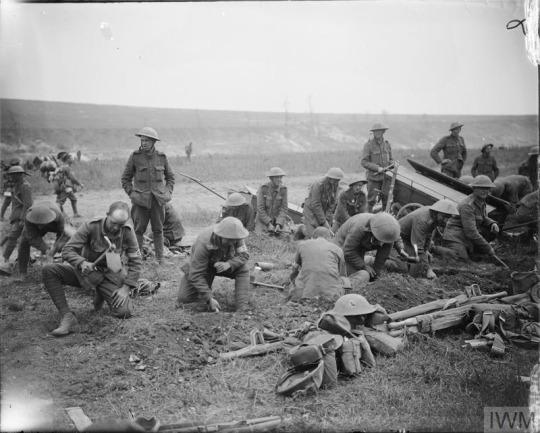#battle of the somme
Text

A British officer of the Army Veterinary Corps in Salonika with his pets which included two jackdaws, a wild goose, a wolf cub and an Alsatian dog. 1916
#World War One#The Great War#1918#1917#1916#1914#first world war#history#historical#historical photos#world history#canadian history#military history#british army#Indian History#war#military#somme#Battle of the Somme#france#belgium#the western front#vimy ridge#Battle of Vimy Ridge
36 notes
·
View notes
Text

Herbert James Gunn (British, 1893-1964), The Eve of the Battle of the Somme, 1916. Oil on canvas, 80 x 87 cm. The Fleming Collection, London
165 notes
·
View notes
Text

The Battle of the Somme took place between 1 July and 18 November 1916. It was one of the largest battles of the First World War, in which more than a million men were wounded or killed, making it one of the bloodiest battles in human history - by John Warwick Brooke (1886 - 1929), English
91 notes
·
View notes
Text

Battles of the Somme. Bringing in the wounded. Stretcher bearer carrying man on shoulder, near Carnoy and La Boisselle, 2nd July, 1916.
34 notes
·
View notes
Text

Men of the Wiltshire Regiment advancing to the attack through the wire, Thiepval, 7 August 1916.
35 notes
·
View notes
Text

Clearing of Captured Trenches
The complete clearing up of captured trenches in which there are deep dug-outs requires a considerable amount of careful arrangement. The following method is suggested:-
A party of men should go forward with each of the leading lines. The men with the first line should remain in the front trench captured. The men with the second line should remain in the second trench captured and so on.
These men should act as ‘Caretakers’ to the trench until the arrival of the proper clearing up party.
They should all be supplied with P[hosphorous] bombs, which they would thrown down into all dug-outs in their portions of the trench. It is believed that the 7th Division used these P bombs with great effect, as they set fire to the dug-outs and the occupants were burnt alive, asphyxiated or forced to come out.
The ‘Caretakers’ should take no prisoners. The reason for this is that should the enemy’s barrage prevent our supporting lines following up the leading lines, captured Germans might be able to empower their guards and then shoot our leading men in the back.
They actually did this more than once e.g. La Maisonnette, where a whole position was recaptured by the prisoners.
Larger parties should advance with the supporting lines and carry out a systematic clearing up of captured trenches.
17/9/16 – II Corps – G. 339. Miscellaneous Notes gathered from Divisions who have taken part in recent offensive operations.
A British No 26 white phosphorous grenade, or P Bomb. Literally just a tin can filled with white phosphorous and intended to produce a smoke cover. Troops also found them very useful for clearing German bunkers.

Headquarters of all units and formations had the responsibility to collect reports and analyse them for lessons that could be learnt from each of the operations they undertook. Every so often documents such as this, compiled from subordinate units, would be disseminated by corps or army headquarters. They're not really official doctrine or rules to be followed, but points for discussion and analysis by commanders. This one covers the first couple of months of the Battle of the Somme.
One of the key issues new units ran into was not "mopping up" positions they'd just captured and a lot of effort was put into remedying this after 1916.
102 notes
·
View notes
Text

Unlikely friendships between two footbal clubs.
Leyton Orient 🏴 & Edinburgh’s Heart Of Midlothian 🏴
A friendship that dates back the early part of The Great War (1914 ~ 1918). Players of Hearts and then-named Clapton Orient led the way as the first professional footballers to volunteer en-masse for what became known as the “Pals’ Battalions”. Both Battalions suffered terrible losses and heavy casualties, with three Orient players and three Hearts players killed on the first day of the Battle of the Somme alone.
To celebrate 150 years of Heart Of Midlothian, next year the Scottish club will host Orient in a pre season friendly at Tynecastle Park. ⚽️
#history#british army#military history#hearts#heart of Midlothian#ww1#world war one#first world war#Somme#battle of the Somme
38 notes
·
View notes
Text
#OTD in Irish History | 18 November:
1657 – Death of Franciscan friar and historian, Luke Wadding, in Rome. Born in Co Waterford, Wadding founded the Pontifical Irish College for Irish secular clergy in Rome. In 1900, Wadding’s portrait and part of his library were in the Franciscan friary on Merchant’s Quay, Dublin. Through Wadding’s efforts, St Patrick’s Day became a feast day.
1703 – The Commons hears a petition from Sir Kildare…

View On WordPress
#irelandinspires#irishhistory#OTD#18 November#Aer Lingus#Anne Bonny#Battle of the Somme#Belfast#Boyle Abbey#Co. Roscommon#George Bernard Shaw#History#History of Ireland#Ireland#Irish Civil War#Irish History#Irish War of Independence#Padraig#Sinn Fein#Today in Irish History
22 notes
·
View notes
Text
Stupid thing 😂😂😂
46 notes
·
View notes
Photo

Un Long Dimanche De Fiancailles - A Very Long Engagement (2004)
#2004#film#movie#WWI#Un Long Dimanche De Fiancailles#A Very Long Engagement#Jean-Pierre Jeunet#Gaspard Ulliel#Manech Langonnet#Manech#Cornflower#Audrey Tautou#Mathilde Donnay#Mathilde#Marion Cotillard#Tina Lombardi#Battle Of The Somme#France
35 notes
·
View notes
Text

Officers of the 27th Division playing badminton in a village (possibly Stavros) in Salonika. 1916
#World War One#The Great War#1918#1917#1916#1914#first world war#history#historical#historical photos#world history#canadian history#military history#british army#Indian History#war#military#somme#Battle of the Somme#france#belgium#the western front#vimy ridge#Battle of Vimy Ridge
52 notes
·
View notes
Text

6 notes
·
View notes
Text
“We are not youth any longer. We don’t want to take the world by storm. We are fleeing. We fly from ourselves. From our life. We were eighteen and had begun to love life and the world; and we had to shoot it to pieces. The first bomb, the first explosion, burst in our hearts. We are cut off from activity, from striving, from progress. We believe in such things no longer, we believe in the war.”
- All Quiet on the Western Front by Erich Maria Remarque
#all quiet on the western front#erich maria remarque#book quotes#ww1#battle of the somme#world war 1#youth#oscars 2023
8 notes
·
View notes
Text

Battle of Bazentin Ridge. British troops digging themselves in by using entrenching tools, Mametz Wood, 17th July 1916.
11 notes
·
View notes
Photo

Indian cavalry await the order to advance on the Somme, 14 July 1916
71 notes
·
View notes
Text

I always enjoy a little bit of logistics, so here's a little on the ammunition that a single British division was allotted for the opening of the Battle of the Somme.
Small Arms Ammunition (SAA):
170 per man
200,000 reserve per Brigade
5,500 per Lewis Gun
3,000 per Vickers Machine Gun
2,188,000 Divisional total
Mills Bombs (hand grenades) – 67,554
Rifle grenades – 5,180
There were 12 British divisions that attacked on that first day, so we're looking around the 25 million rounds of rifle ammunition for that attack alone.
38 notes
·
View notes